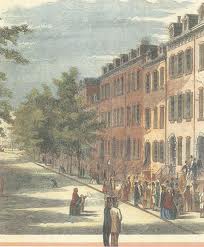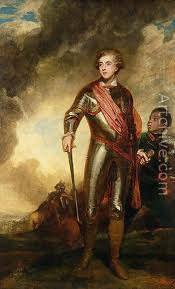From The Letter Bag of Lady Stanhope
. . . . . It was in the Harrington branch that the foibles of the beau monde were cultivated with intention.
 |
| Jane Fleming, later Countess of Harrington by Sir Joshua Reynolds |
Charles, 3rd Earl of Harrington, born the same year as Charles, 3rd Earl Stanhope, had married Jane, daughter and heiress of Sir John Fleming, Bt., who proved no unworthy successor to her celebrated predecessor immortalised by George Selwyn for vivacity and abnormal conversational powers. The drawingroom of this later Lady Harrington was recognised as a great social centre where her friends could meet, if not actually without invitation, at least at a shortness of notice which marked the informality of the entertainment and lent to it a subtle charm. The hostess, whose energy was unbounded, would go out in the morning and pay about thirty calls, leaving at each house an invitation bidding her friends to assemble at Harrington House that same evening.
 |
| Bond Street |
She would then walk up Bond Street at the hour at which the fashionable young men of the day were likely to be abroad, and would dart from one side of the road to the other as she spied a suitable object for her purpose. A circle of friends assembled thus three or four times a week, resulted in the formation of a recognised clique, the delightful informality of which was much appreciated by her young relations from Grosvenor Square, and the entrte into which was much envied by those who were admitted only to the larger and more stately parties reserved for the less favoured.
 |
| Charles Stanhope, Earl of Harrington copyright 1st Art Gallery |
Nor were Lady Harrington’s impromptu evening assemblies less celebrated than her perpetual teadrinkings at Harrington House. The superior quality of this expensive beverage in which the family of Stanhope indulged there, and the frequency with which Lady Harrington presented it to her visitors at all hours of the day, gave rise to the saying that where you saw a Stanhope, there you saw a tea-pot. A story current in town was that when her son, General Lincoln Stanhope, returned home after a prolonged absence in India, he found the family party precisely as he had left them many years before, seated in the long gallery sipping their favourite refreshment. On his entry, his father looked up from this absorbing occupation, and, with a restraint indicative of the highest breeding, gave voice to the characteristic greeting—” Hullo! Linky, my dear boy, you are just in time for a cup of tea!”
 |
| Votaries of Fashion. St. James’s Lord Petersham, etc. (Charles Stanhope, 4th Earl of Harrington) copyright National Portrait Gallery |
Such a home was the very atmosphere in which to develop a fashionable man of the period; and the eldest son of the House, Charles, Lord Petersham, did not discredit his surroundings. Tall, handsome, and faultlessly clad, he was one of the most celebrated dandies of his day. Decidedly affected in his manners, he spoke with a slight lisp; and since he was said to recall the pictures of Henri IV., he endeavoured to accentuate this likeness by cultivating a pointed beard. He never went out till six in the evening, and one of his hobbies indoors was the strenuous manufacture of a particular sort of blacking which, he always maintained, once perfected, would surpass every other. His sitting-room emphasized his eccentricity. One side of it represented the family penchant, being covered with shelves upon which were placed canisters containing the most expensive and perfect kinds of tea. On the other, in beautiful jars, reposed an equally choice and varied assortment of snuffs. Lord Petersham’s snuff-boxes and his canes were alike celebrated; indeed, his collection of the former was said to be the finest in England, and he was reported to have a fresh box for every day in the year. Thus Gronow relates that once when a light Sevres box which he was using, was admired, Lord Petersham responded with a gentle lisp—” Yes, it is a nice summer box—but would certainly be inappropriate for winter wear!”
 |
| Interior of Harrington House copyright 1st Art Gallery |
Caricatures of the period represent the heir to the Earldom of Harrington clad in light trousers and a brown coat, seated upon a brown prancing horse. One of his whims, indeed, was to affect everything brown in hue—brown steeds, brown liveries, brown carriages, brown harness and brown attire. This was attributed to the fact of his having been in love with a fair widow of the name of Brown, whose charms he thus endeavoured to immortalise; but whatever the truth of this rumour, it is evident from the letter of Marianne Stanhope, that at the age of twenty-five he honoured with his devoted attention a lady whose personal attractions and unamiable disposition afforded a fund of entertainment to his relations living next door to her in Grosvenor Square. And this sidelight on the character of the dandy gives pause to criticism. How much, perhaps, of the eccentricity for which Lord Petersham was remarkable, like that of the celebrated Lady Hester Stanhope, may be attributed to the buffetings of a secret fate? Yet, this man who, with exceptional abilities and exceptional opportunity for exercising those abilities, could contentedly fill his empty days with the manufacture of blacking, or pass an entire night, as Gronow relates him to have done, playing battledore and shuttlecock for a wager with Ball Hughes, was, in much, a typical product of his generation. His mannerisms were accepted by his contemporaries with a forbearance which bordered on admiration, and, however childish his peculiarities, he remained unalterably popular.
I can completely understand an obsession with tea as it happens to be one of mine. My relatives all know a gift of teas or anything to do with tea will always be well received!
I think the young man sounds adorable! The idea of someone striving to be an original has a great deal of appeal for me, as today so many young men strive to be exactly like some of the worst examples of the male animal possible.